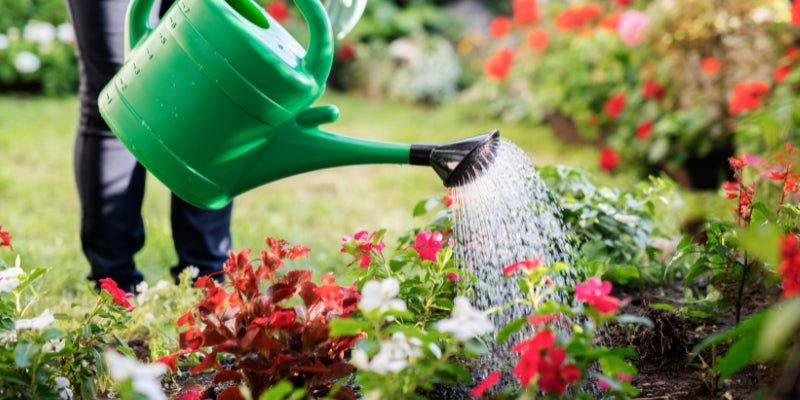Summer Watering Tips
Introduction
Summer sunshine is just lovely, isn't it? The feeling of the sun on our face, something cool to drink and the enchanting summer garden sounds. But with these stunning summer scenes comes the responsibility to water wisely.
Keeping your garden hydrated without wasting water requires a bit more thinking and strategy than you might initially think. These tips will help you nurture plant health, conserve water, and grow a healthy, vibrant garden - all year round.
Best Time to Water
Watering timing matters. The ideal window is early in the morning (6–10 am), when soil efficiently absorbs moisture before the heat kicks in. Plus, damp foliage dries faster - helping to prevent fungal issues including powdery mildew and grey mould.
"But I'm too busy in the morning to even think about watering the garden!"
We hear you.
Evening watering (after 6 pm) is a viable alternative for those with busy mornings. Just avoid drenching leaves overnight, which can promote mildew.
Avoid watering midday when evaporation is highest, because water simply evaporates before it can reach the roots.
How Often & How Much to Water
Different plants and growing conditions require different watering styles.
Seedlings & Newly Planted Trees or Shrubs
These require frequent watering, every day or every other day, while they establish. Their shallow roots dry out fast and lack drought resilience.
Containers & Hanging Baskets
These systems often dry out quickly in the sun. Check moisture about 3 cm down and water if it feels dry.
Established Beds & Shrubs
Water deeply once or twice weekly. Encouraging root growth below the surface builds resilience against drought.
Soil Type:
- Light, sandy soils require lighter, more frequent watering.
- Heavy clay soils suit deeper, less frequent watering that penetrates the dense structure.
As a general guide: Aim for 25–30 L per m² per week in most beds, and 30–50 L/m² for vegetables during dry spells.
What to Use and How to Water Effectively
There's a million and one tools out there. Some are tried and tested whilst some are newer.
-
Watering Cans – A classic! Best for targeted watering around roots.
-
Hosepipes with Adjustable Nozzles – Ideal for larger areas or vegetable plots.
-
Drip or Seep Irrigation – Delivers water directly to roots with minimal waste.
-
Self-Watering Containers & Terracotta Spikes – Great for container plants when you're away. They slowly release water over several days.
- Timers & Moisture Sensors – Take the guess work out of the equation. Help automate your watering routine efficiently.
Water-Saving Strategies
Tackling summer drought sustainably means smarter watering:
- Mulch 5 - 8 cm deep using organic matter like compost or bark. This retains moisture, suppresses weeds, and improves soil structure.
- Group plants with similar water needs together to simplify watering and reduce waste.
- Collect rainwater using water butts - they're both eco-friendly and cost-effective, especially during water restrictions.
- Water the soil, not leaves to maximise uptake and avoid encouraging leaf diseases.
Deep Watering
Deep watering is key to building drought-resistant roots. We recommend:
- Slow, deep soak using a garden wand - aim to penetrate 15–20 cm, or even deeper for trees.
- Drip irrigation or soaker hoses placed close to the base of the plant ensure moisture reaches soil deeply.
- Improve soil with organic matter to help its capacity to hold water and support healthy roots.
Strong root systems not only access deeper moisture during dry spells but also improve nutrient uptake and boost plant health.
Advice & Common Mistakes
- Check before watering: A 2 cm finger test helps prevent overwatering. If moisture is present, wait.
- Avoid overwatering: Too much water suffocates roots and leads to issues like rot and poor growth.
- Avoid watering foliage: Target roots to reduce disease risks.
- Support vulnerable plants: Containers, young trees and greenhouse crops take priority during dry spells.
- Let mature shrubs and lawns cope: These often recover quickly when the rains return.
Drought-Resilient Garden
If you're looking to invest in a long-term strategy to keep your garden looking lush summer after summer, follow our tips below.
- Add organic matter to improve soil structure and moisture retention.
- Design rain gardens or install wicking beds to capture and store rainwater effectively.
- Mulch before bans hit: A deep mulch before a hosepipe ban helps conserve summer moisture.
Frequently Asked Questions (FAQs)
Q: How much water do beds and borders need each week?
Aim for 25–30 L per m², increasing to 30–50 L/m² in vegetable beds during hot, dry weather.
Q: Is morning or evening best to water?
Morning is ideal - soil absorbs moisture efficiently and foliage dries quickly, reducing disease risk.
Q: How do I know when plants need watering?
Use a finger to check 2 cm down. If the soil is dry, it’s time. If it feels moist, wait.
Q: Should I wet plant leaves while watering?
No - focus on the base to prevent fungal disease and evaporation loss.
Q: Can I water plants while I'm away?
Yes - use self-watering pots or terracotta spikes, which can sustain plants for several days.
Final Thoughts from Mail Order Trees
Summer watering doesn’t have to feel like a chore. If you water at the right time, support deep root growth, and conserve water with mulches and rain collection, your garden will be vibrant and healthy, season after season.
Happy gardening.
Suggested Articles


